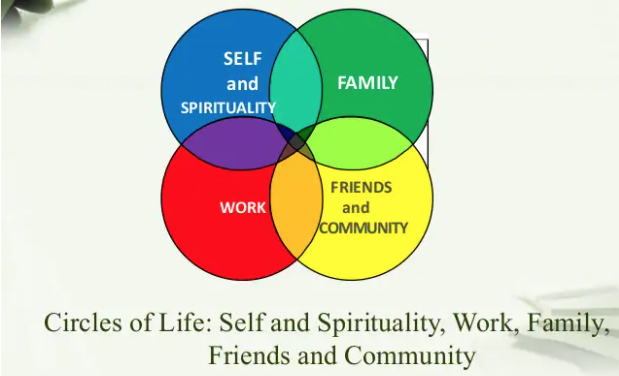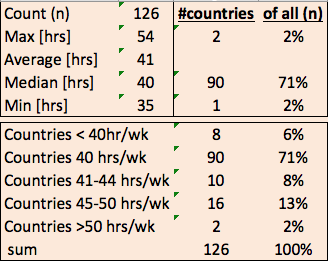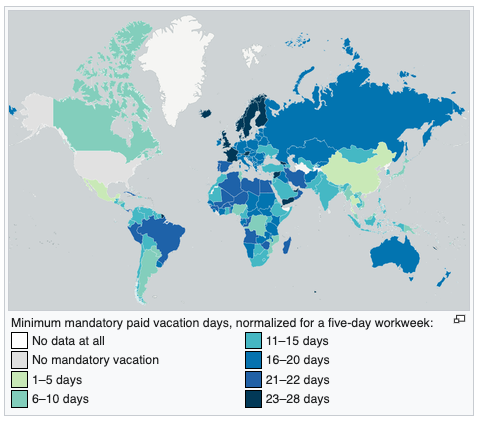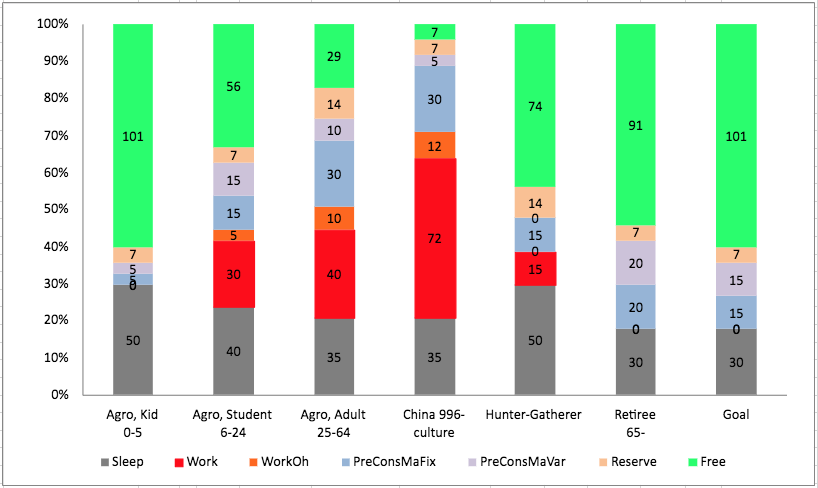Contents
- 1 The 15 Movement, by J&P
- 2 15 Klubben, 15 Club
- 3 Background – Modern People Work a Lot
- 4 Work-Life Balance
- 5 Work Productivity – Or Lack Thereof…
- 6 Workweek – Some Countries’ Statistics
- 7 Vacation – Some Countries’ Statistics
- 8 Time Management
- 9 996 Culture – 72 Hour Workweek, and Tang ping (China)
- 10 The Great Resignation (2021-) (US, prim.)
- 11 Re-Opening, Post Covid-19
- 12 12,000 years ago…
The 15 Movement, by J&P
Simply aiming for a more focused and modern work-life balance including:
- Live Now, Not Later.
- While you can, if/when get sick, it can be over.
- Do what you Want, minimize what you Have to.
- From some baseline of around working 40 hours per week*, aim is ‘more towards 15 than 60’.
- More time for and with relatives and friends.
*) A majority of countries do have 40 hrs/wk. US and North Korea 47 hrs and 48 hrs respectively are in top ten of countries where people work longest hours per week. (Yeah, just had to write that sentence like that, grouping together those two countries….) Source: wikipedia: Workweek and weekend, and ref#3 in reference materials (KEY20210629A)
Side-note: In the US there is also a movement (since many years when write this in 2021) for trying to raise the minimum wage to US$ 15/hr. (wikipedia: Fight for $15, which will be part of results if search on any form of ’15 movement – google 15 movement)
15 Klubben, 15 Club
Informal club of members who shares tips and techniques for a healthy work-life balance.
Membership is through personal invitation only.
Background – Modern People Work a Lot
It was a very rainy 4th of July weekend and some time was spent on philosophy after listening to a quite interesting podcast opinion piece:
Lite bra exemplifiering hur kapitalt annorlunda funktionen av att producera och konsumera saker kan vara. Som motpol till vårt extrema konsumtionssamhälle som tär på alla våra naturresurser.
 Full document with table above and more comments – AllocationOfTime-HowAreYouSpendingYourLife.pdf
Full document with table above and more comments – AllocationOfTime-HowAreYouSpendingYourLife.pdfJ The Philosopher
References
- 15 Hour
- google.com/search?q=15-Hour+Week
- ‘In 1930, British economist John Maynard Keynes predicted that technological change … lead to a 15 hour workweek’… – The misunderstood 15 hour work week of John Maynard Keynes
hackernoon.com/the-misunderstood-15-hour-work-week-of-john-maynard-keynes-9d4561c96ab6
- General, definitions
- (Work-Life Balance moved below to own section.)
- (Workweek moved below to own section.)
- Studies
- A 4-day workweek is the norm in Iceland. Could the same become true in the U.S.?
cnbc.com/2021/07/12/a-4-day-workweek-is-the-norm-in-iceland-could-the-us-follow-.html - Study: Shorter workweek leads to increased happiness, no loss in productivity
nbc15.com/video/2021/07/15/study-shorter-workweek-leads-increased-happiness-no-loss-productivity/
- A 4-day workweek is the norm in Iceland. Could the same become true in the U.S.?
Day-View
Note: in general, discussions on this topic commonly use hours PER WEEK as unit.
The graphic below takes the hours figures used in Hours per Week graphic (above) and divide each by 5, and using ‘5’ for two primary reasons:
- Will make the 40 hrs per week at work correspond to 8 hrs per day, the more common workweek for many workers in industrialized countries.
- Makes the two graphics – per Week and per Day look the same, just hours numbers shown are different.
BUT, trying to convert a Week-view into a Day-view becomes actually way more complicated than what one first may think…
- Dividing all figures in Per Week data by 5 to get some Per Day data really isn’t working correctly from a mathematical view (must use 7 days per week to get maths to match up).
- Just that using 7 instead creates “weird” day-numbers (40 hrs work / 7 = 5.7, not the 8 hrs / day as one ‘would expect’)
- Adding up number in the Week view DO add up correctly to 168 hrs per week (7*24) but adding up numbers as shown in Day view (graphic below) adds up to 33.6 hrs/day (the 168 hrs per week / 5 = 33.6, which should be 168/7 = 24, but which would mess up graphical representation and make Week and Day views look very different)
- Ok, 40 hours work per week is common norm for workers today, but can have a number of special cases one should consider, like
- A Hunter-Gatherer would hunt/work more like every day, 7 days a week, and thus his 15 hrs/week should then be more like 2 hrs per day ‘at work’ (15/7 = 2.1)
- And it’s actually ONLY the Agro Worker that would have a more controlled, defined, workweek of (e.g.) 5 days, all other categories (like Agro Kid, Agro Student, etc) would have more flexibility and work would be spread out over the whole 7-days week.
- (Same logic goes for Work Overhead – only applies to days actually worked.)
- To make any Per Day representation of how time could be spent Per Day one should actually better use different dividers for both different categories of people and different activities. Something maybe like:
- Agro Worker, Work and Work Overhead: divider 5, for 5 days workweek
- Hunter-Gatherer, correspondingly: divider 7, as hunt every day
- et c
- (Altogether, a completely different approach may be better. Start with looking at each day and estimate time per people category and activity, work through each in week, and get figures that matches up to expectations, like 8 hrs work / per day. Though, graphic representations of Week v Day will be very different. Pros and cons with every approach.)
I.e. be careful with digesting the graphic below!
Work-Life Balance
- en.wikipedia.org/wiki/Work%E2%80%93life_balance
- en.wikipedia.org/wiki/Category:Work%E2%80%93life_balance
- google.com/search?q=work-life+balance
- What’s Out Of Whack? The Four Spokes Of Life Can Bring Greater Work/Life Balance, Forbes, Jul 18, 2020
- The Four Spokes of Life:
- Work
- Family
- Play
- Self-Care
- The Four Spokes of Life:
- Google four life quadrants: Work, Family, Friends and Self.
Source: A presentation by a D Fernandez, College instructor Cavite State University
Work Productivity – Or Lack Thereof…
- IT’s Biggest Time Wasters (and How to Fix Them), informationweek, 2021-08-27
- The White-Collar Struggle: Productivity in the Information Age, theeconreview.com, 2019-04-24
- 2 hr 53 min / day, UK ! (would correspond to 14 h 25 min per 5-day week)
- 2 hrs 48 min / day, US ! (would correspond to 14 h per 5-day week)
- “UK workers found that the average office worker was only productive for 2 hours and 53 minutes while RescueTime studied 185 million working hours and found that the average knowledge worker— one who mainly works with information rather than manual labor— in the U.S. was productive for only 2 hours and 48 minutes a day in 2018.”
You see? Productivity-wise, “we” as societies are already there, white-collar seems to produce about, or actually slightly less than, what a 15 hours per week would achieve, 15 hours dedicated work and not hanging around the water cooler, …
Reading the Fine Print [in legal documents, like SW licenses]…
Btw, one thing that UK and US share is they both have common law system and how much time is spent – or should be spent – by reading all fine prints in legal dealings, including reading those web cookies statements and selecting which ones you want to accept or not, license agreements for the softwares your using.
(Where contracts in civil law systems can be 5 pages – as the details are hard-written in law texts, corresponding paperwork in common law can easily be 100 pages – as all details must be sorted out in each legal document; laws are more guidelines, all this from multiple personal real cases by J&P Group who deals in both law systems.)
Hey, it really easy to see productivity falling through the floor! Actually taking time and reading fine prints and I wonder if can even achieve any 2 hrs 48 min in the US, or 2 hrs 53 min in UK, …..
(There is an OAS touching on the subject of Science-Laws-Politics-and-more Venn Diagram, OAS 180007, which can be used to consider / evaluate / investigate how time is spent by an individual or organization. How much time each day is spent on “Science” – read/interpret as Real-Work/Productive work, then how much time due to laws/legal systems, politics, disruptions and handling of “alternative facts”, and so on.)
Workweek – Some Countries’ Statistics
- en.wikipedia.org/wikiWorkweek_and_weekend
- google.com/search?q=workweek
- dictionary.com/browse/workweek
Source: data from en.wikipedia.org/wikiWorkweek_and_weekend
SOME examples:
- 35 hrs – France, Kuwait
- 37 hrs – Denmark
- 37.5 hrs – Norway, United Kingdom
- 38 hrs – Australia, Belgium, Finland
- 38.5 hrs – Austria, Germany, Surinam
- 40 hrs – some 90 countries,
- Europe: (e.g.) majority of EU countries including Ireland, Italy, Greece, Sweden, …
- North America: (e.g.) Canada, Mexico, and US
- 41 hrs – Switzerland
- 42 hrs – China
- 48 hrs – Costa Rica, Colombia, India, North Korea, …
- 50 hrs – Burundi and Cameron
8-Hour Day
- en.wikipedia.org/wiki/Eight-hour_day
- google.com/search?q=8+hour+work+day+history
- Even a national holiday in (parts of) Australia – nationaltoday.com/eight-hours-day/
- “Eight Hours Day in Australia is celebrated on the second Monday in March in some parts of Australia.”
Vacation – Some Countries’ Statistics
While on topic of statistics and data about countries around our world – here’s a bit on annual leave.
- en.wikipedia.org/wiki/Annual_leave
- en.wikipedia.org/wiki/List_of_minimum_annual_leave_by_country
- google.com/search?q=annual+leave
From en.wikipedia.org/wiki/List_of_minimum_annual_leave_by_country: (Sortable table, click on header.)
| Country | Paid vacation days | Paid public holidays | Total paid leave |
|---|---|---|---|
| Australia | 20 | 10 | 30 |
| Brazil | 10-22 | 12 | 22-34 |
| Canada | 10-20 | 6-10 | 16-30 |
| China | 5-15 | 11 | 16-26 |
| Denmark 🇩🇰 | 25 | 11 | 36 |
| EU, minimum | 20 | 0 | 20 |
| Finland 🇫🇮 | 25 | 11 | 36 |
| France | 25-37 | 11 | 36-58 |
| Germany | 20 | 10 | 30 |
| Ireland | 20 | 9 | 29 |
| Italy | 20 | 12 | 32 |
| Mexico | 6 | 7 | 13 |
| Norway 🇳🇴 | 25 | 10 | 35 |
| Spain | 22 | 11 | 33 |
| Sweden 🇸🇪 | 25 | 9 | 34 |
| United Kingdom | 20 | 8-10 | 28 |
| United States 🇺🇸 | 0 (Yes, Zero) | 0 | 0 |
United States: “There is no federal or state statutory minimum paid vacation or paid public holidays. Paid leave is at the discretion of the employers to its employees.[187][188] According to the US Bureau of Labor Statistics, 77% of private employers offer paid vacation to their employees; full-time employees earn on average 10 vacation days after one year of service.[189] Similarly, 77% of private employers give their employees paid time off during public holidays, on average 8 holidays per year.[189][190] Some employers offer no vacation at all.[191] The average number of paid vacation days offered by private employers is 10 days after 1 year of service, 14 days after 5 years, 17 days after 10 years, and 20 days after 20 years.[189][192]”
Time Management
Source: protradeunited.com.au/the-four-quadrants-of-time-management/
996 Culture – 72 Hour Workweek, and Tang ping (China)
Last section and more a parentheses, example of What Not to Aim For!! What kills people prematurely.
On the other side of work-life spectrum, from commonly 40 hrs per week, and more human aim towards 15 hrs, we have China with some companies having 72 hour workweeks.
“The 996 working hour system (Chinese: 996工作制) is a work schedule practiced by some companies in the People’s Republic of China. It derives its name from its requirement that employees work from 9:00 am to 9:00 pm, 6 days per week; i.e. 72 hours per week.” [wikipedia]
- en.wikipedia.org/wiki/996_working_hour_system
- Explainer | What is China’s 996 work culture that is polarising its Silicon Valleys? scmp.com, 9 Jun 2021
- This is 996 culture, a grueling 72-hour work week popular in China that’s been criticized for ruining work-life balance, news.yahoo.com, Jul 24, 2021
- google.com/search?q=996+culture
How the 996-culture could be looking like:
Scary!
Assumptions/data used for illustrating 996-culture:
- Similar hours sleep as Adult agro, suspect figure could actually be lower
- 72 hors workweek, 9a-to-9p, 6 days a week
- 6 x 2 hrs for overhead, corresponding commute as other industrious areas (1 hr, but 6 days instead of 5 per week)
- Using same 30 hrs / week for prepare-consume-maintain things, similar to any adult in Agro culture.
- Using 5 hrs for variable prep-cons-maintain, half of as in agro,adult (assuming less assets)
- 7 hrs for reserve (half of agro, adult), essentially to provide ANY free time
- All this results in 7 hrs free time per week. Which is probably questionable and would be actually more sleep.
Tang ping – the Anti-Movement
The Great Resignation (2021-) (US, prim.)
Movement that really took of in the second year of Corona.
- 2019-Dec, first case identified en.wikipedia.org/wiki/COVID-19
- 2020: First year, countries and companies started shutting down during the spring
- 2021: 2nd year, The Great Resignation starts
- 2022 Q1: first signs of more global re-opening of countries (e.g. in Europe, New Zealand which has had among the stricter and longer restrictions, closed borders even for own citizens)
“The Great Resignation, also known as the Big Quit,[2] is an economic trend in which employees voluntarily resign from their jobs en masse, beginning in early 2021, primarily in the United States.” [wikipedia]
- en.wikipedia.org/wiki/Great_Resignation
- google.com/search?q=the+great+resignation
- “Toxic Culture Is Driving the Great Resignation”, MIT Sloan 2022-01-11 [link] [PDF]
- Top predictors for happening
- Toxic corporate culture – 10.4 times more like to contribute to attrition than compensation
- Duh, and not a surprise in the US …
- Job insecurity and reorganization – 3.5 times
- Nor really surprise in the US …
- High levels of Innovation – 3.2 times
- This was / is a surprise, that people are leaving at HIGHER rate a*AT* innovative companies (but explanation is higher demands, working longer hours, et c)
- Failure to recognize employee performance- 2.9 times
- failure to distinguish between high performers and laggards
- Poor response to COVID-19- 1.8 times
- The same pattern holds true when employees talk more generally about their company’s policies for protecting their health and well-being.
- Toxic corporate culture – 10.4 times more like to contribute to attrition than compensation
- Short-Term Steps for Companies to Increase Retention
- Lateral career opportunities
- Remote work arrangements
- Company-sponsored social events
- Offering predictable schedules
- Top predictors for happening
Re-Opening, Post Covid-19
Put here and with a Swedish reference, in Swedish, as a little bit indirect comparison to The Great Resignation and it’s more US-phenomena. There are limited similar as-significant events in Sweden – and would put that to the fact the Swedish employer – employee market is way more in balance, much more negotiations, with or without any involvement of any employee organizations, than US and employer been the party deciding much more. Traditionally. The future will be interesting.
 Exempel på hur Sverige’s arbetsmarknad ser ut att kunna förändras.
Exempel på hur Sverige’s arbetsmarknad ser ut att kunna förändras.
Intressant artikel i DN 2022-02-09,
‘Sverige öppnar – men vissa saker blir inte som förr’ [länk, PDF]- Bostadsmarknaden
(bl.a.) p.g.a. mer distansarbete, flexibility från arbetsgivare:- Mer efterfrågan på större hus/boendet
- Mindre efterfrågan på central beläget
- Företagandet
- Arbetsmarknaden
- Störningar i ekonomin och inflationshot
- Bostadsmarknaden
- Article(s) in English will be added once stumble upon a worthy one
12,000 years ago…
- en.wikipedia.org/wiki/Human
- Humans (Homo sapiens
- ‘ Until about 12,000 years ago, all humans lived as hunter-gatherers.[43][44] The Neolithic Revolution (the invention of agriculture) first took place in Southwest Asia and spread through large parts of the Old World over the following millennia.[45] It also occurred independently in Mesoamerica (about 6,000 years ago),[46] China,[47][48] Papua New Guinea,[49] and the Sahel and West Savanna regions of Africa.[50][51][52] Access to food surplus led to the formation of permanent human settlements, the domestication of animals and the use of metal tools for the first time in history. Agriculture and sedentary lifestyle led to the emergence of early civilizations.[53][54][55]‘
- en.wikipedia.org/wiki/Hunter-gatherer
- en.wikipedia.org/wiki/Agrarian_society






